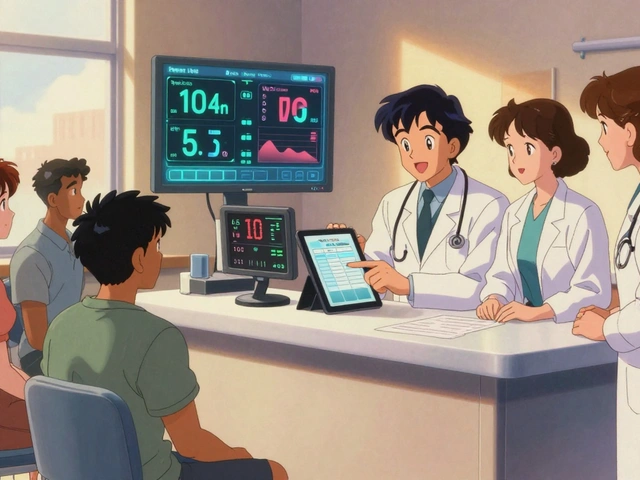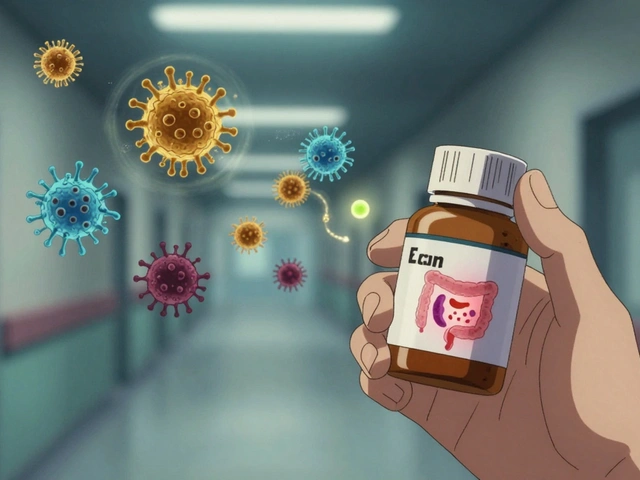Menopause Heart Disease Risk Calculator
This tool estimates your risk of developing heart disease after menopause based on key factors. Enter your information below to get personalized insights.
Your Estimated Risk Level:
When women reach Menopause, the body undergoes a shift in hormone production that can affect more than just hot flashes. Recent research shows a clear connection between this life stage and the risk of developing heart disease, the leading cause of death for women in the United States. Understanding how the two are linked helps you take proactive steps to protect your heart.
Key Takeaways
- After menopause, estrogen levels drop, which can raise blood pressure, increase LDL cholesterol, and reduce arterial flexibility.
- Women’s heart disease risk catches up to men’s within 10‑15 years after menopause.
- Modifiable lifestyle choices-diet, exercise, and smoking cessation-have a bigger impact post‑menopause.
- Hormone replacement therapy (HRT) can lower some cardiovascular risks, but timing and individual health profile matter.
- Regular cardiovascular screening becomes crucial once you hit menopause.
How Hormonal Changes Influence the Heart
During the pre‑menopausal years, the hormone Estrogen acts like a protective shield for blood vessels. It encourages the production of nitric oxide, a molecule that keeps arteries relaxed and prevents plaque buildup. When estrogen production fades during menopause, several things happen:
- Blood pressure rises - Without estrogen’s vasodilating effect, arteries can stiffen, pushing systolic numbers higher.
- Bad cholesterol climbs - Low‑density lipoprotein (LDL) often spikes, while high‑density lipoprotein (HDL) can dip.
- Inflammation increases - Markers like C‑reactive protein tend to be higher, signaling more arterial inflammation.
These shifts collectively elevate Cardiovascular Risk and set the stage for Heart Disease development.

Statistical Snapshot: Menopause and Heart Disease Risk
Data from the American Heart Association (2023) reveal that women’s fatal heart disease rates increase from 1.2% per year before menopause to 2.3% per year after the transition. A longitudinal study of 5,000 women followed for 20 years found:
- Women who entered menopause before age 45 had a 30% higher odds of coronary artery disease.
- Those who started hormone therapy within five years of menopause showed a 15% reduction in heart‑attack risk compared to non‑users.
- Regular aerobic exercise (150 minutes per week) cut post‑menopausal heart disease risk by roughly 25%.
Modifiable Risk Factors After Menopause
While you can't stop menopause, you can control many of the factors that drive heart disease:
| Risk Factor | Pre‑Menopause | Post‑Menopause |
|---|---|---|
| Estrogen Level | High | Low |
| Blood Pressure | Average 110/70 mmHg | Average 120/80 mmHg |
| LDL Cholesterol | ~100 mg/dL | ~130 mg/dL |
| Inflammation Markers | Low CRP | Elevated CRP |
| Physical Activity | Variable | Critical - 150+ min/week |
Focus on diet rich in omega‑3 fatty acids, whole grains, and plenty of fruits and vegetables. Cutting back on processed sugars and trans fats helps control LDL spikes that often follow menopause.
Hormone Replacement Therapy: Benefits and Caveats
HRT supplies synthetic estrogen (and sometimes progesterone) to fill the hormonal gap. For many women, it reduces hot flashes, improves bone density, and can improve lipid profiles. However, the decision isn’t one‑size‑fits‑all:
- Timing matters - Starting HRT within 10 years of menopause onset, or before age 60, shows the most cardiovascular benefit.
- Women with a history of blood clots, breast cancer, or uncontrolled hypertension should avoid systemic estrogen.
- Low‑dose transdermal patches tend to have a lower risk of clotting than oral pills.
Always discuss personal risk factors with a cardiologist or menopause specialist before beginning any regimen.

Screening Recommendations for Post‑Menopausal Women
Regular check‑ups become a cornerstone of heart health after menopause. Here’s a practical schedule:
- Blood pressure - Every visit, aim for under 120/80 mmHg.
- Lipid panel - Every 1-2 years, or sooner if you have diabetes or a family history of early heart disease.
- Blood glucose - Fasting glucose or HbA1c annually to catch insulin resistance early.
- Electrocardiogram (ECG) - Baseline at 55, then repeat if you develop symptoms or have additional risk factors.
- Coronary calcium scan - Consider for women with multiple risk factors; it quantifies plaque buildup.
Early detection is key because many heart attacks in women present with subtle symptoms like fatigue, shortness of breath, or indigestion.
Practical Lifestyle Changes That Boost Heart Health
Putting knowledge into action is what really matters. Below are proven habits that help offset the cardiovascular impact of menopause:
- Move daily - Aim for 30 minutes of brisk walking, cycling, or swimming, five days a week.
- Mind your meds - Statins, ACE inhibitors, or low‑dose aspirin may be recommended based on your risk profile.
- Manage stress - Practices like yoga, meditation, or even a hobby can lower cortisol, which otherwise raises blood pressure.
- Quit smoking - Smoking accelerates arterial stiffening; quitting can reverse some damage within years.
- Sleep well - Aim for 7-8 hours; poor sleep spikes inflammation and blood pressure.
Even small tweaks add up. A 2022 meta‑analysis showed that women who added just 15 minutes of moderate exercise each day reduced their post‑menopausal heart disease risk by 12%.
Frequently Asked Questions
Does menopause guarantee I will get heart disease?
No. Menopause increases the probability of cardiovascular issues, but genetics, lifestyle, and medical management determine actual outcomes. Women who stay active, eat heart‑healthy, and undergo regular screening often keep a low risk.
Should I start hormone therapy to protect my heart?
Only if you meet specific criteria. Starting HRT within ten years of menopause and under age 60 can be cardioprotective, but it’s not suitable for everyone. Consult a healthcare provider to weigh benefits against risks like clotting or certain cancers.
What are the most common heart‑disease symptoms after menopause?
Women often experience atypical signs such as unexplained fatigue, shortness of breath, upper‑back discomfort, or nausea. Classic chest pain can still occur, but it’s less frequent than in men.
How often should I get cholesterol checked after menopause?
Every 1-2 years is standard for most women, but if you have diabetes, a family history of early heart disease, or are on HRT, an annual test is advisable.
Can a plant‑based diet lower my post‑menopausal heart risk?
Yes. Studies show that women who follow a predominantly plant‑based diet see a 20% drop in LDL cholesterol and better blood‑pressure control, both of which curb heart disease risk after menopause.







Dean Briggs
October 6, 2025 AT 13:47Menopause marks a profound hormonal transition that reshapes cardiovascular physiology.
As estrogen wanes, the protective vasodilatory effects diminish, leaving arterial walls more susceptible to stiffness.
This biochemical shift intertwines with age‑related changes in lipid metabolism, often heralding a rise in LDL cholesterol.
Moreover, the autonomic nervous system recalibrates, sometimes increasing resting heart rate and peripheral resistance.
Consequently, the aggregate of these factors tips the scale toward a heightened probability of coronary artery disease.
Yet, this risk is not immutable; lifestyle interventions can act as a counterbalance to the inevitable drift.
Regular aerobic exercise, for example, stimulates endothelial nitric oxide production, partially restoring vascular compliance.
Dietary patterns rich in omega‑3 fatty acids and soluble fiber can attenuate the surge in serum triglycerides common after menopause.
Smoking cessation, likewise, removes a potent catalytic agent that accelerates atherosclerotic plaque formation.
Blood pressure management through modest sodium reduction and stress‑relieving practices can further blunt the hypertensive surge.
Family history remains a non‑modifiable component, but awareness empowers proactive screening and shared decision‑making.
The risk calculator presented in the article serves as a heuristic, translating raw numbers into an intuitive risk tier.
While the algorithm simplifies complex physiology into a point score, it reminds us that each point represents a modifiable behavior or condition.
Embracing this knowledge, women can negotiate the menopausal interval with a blend of medical guidance and personal agency.
Ultimately, the intersection of biology and choice determines whether the heart endures the menopausal storm or emerges resilient.
Sadie Speid
October 18, 2025 AT 20:59Kick that heart disease risk into gear! By logging your numbers daily and squeezing in 30 minutes of brisk walking, you’re already stacking the odds in your favor. Keep that cholesterol check on schedule and watch the calculator flash a greener light!
Sue Ross
October 31, 2025 AT 03:11I hear you, staying consistent can feel like a marathon, but those incremental wins add up nicely. Remember to celebrate each week you hit your activity goal.
Rohinii Pradhan
November 12, 2025 AT 10:23Permit me to elucidate the nuanced interplay between estrogen deficiency and endothelial dysfunction, a veritable cascade of pathophysiological events. The diminution of nitric oxide bioavailability precipitates vasoconstriction, while concomitant oxidative stress accelerates lipid oxidation. Such mechanisms, when compounded by sedentary proclivities, inexorably augment atherogenic potential. Diligent adherence to the preventive stratagems delineated above, therefore, constitutes an exigent medical imperative.
Anna-Lisa Hagley
November 24, 2025 AT 17:35The article glosses over the grim reality for many women.
A Walton Smith
December 7, 2025 AT 00:47Sure.
Theunis Oliphant
December 19, 2025 AT 07:59The complacency implied by a curt 'Sure' betrays a deeper societal indifference to women's health. We must rise above such lukewarm responses and demand rigorous preventive care. Only then can we hope to shield our mothers and sisters from needless cardiac tragedy.